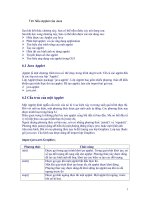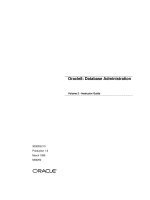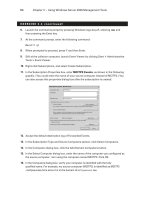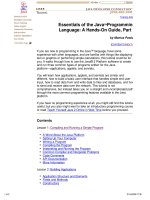Sun certified programmer developer for java 2 study guide phần 1 doc
Bạn đang xem bản rút gọn của tài liệu. Xem và tải ngay bản đầy đủ của tài liệu tại đây (1.39 MB, 68 trang )
Color profile: Generic CMYK printer profile
CertPrs8(SUN) / Sun Certified
Composite Default screen
Programmer & Developer for Java 2 Study Guide / Sierra / 222684-6 / Chapter 1
Blind Folio 1:1
Part I
The Programmer’s
Exam
CHAPTERS
1
Language Fundamentals
2
Operators and Assignments
4
Flow Control, Exceptions, and Assertions
5
Object Orientation, Overloading and
Overriding, Constructors,
and Return Types
Java.lang—The Math Class, Strings,
and Wrappers
7
Objects and Collections
8
Inner Classes
9
Threads
Declarations and Access Control
3
6
P:\010Comp\CertPrs8\684-6\ch01.vp
Wednesday, November 13, 2002 5:21:32 PM
Color profile: Generic CMYK printer profile
CertPrs8(SUN)
Composite Default screen
P:\010Comp\CertPrs8\684-6\ch01.vp
Wednesday, November 13, 2002 5:21:32 PM
/ Sun Certified Programmer & Developer for Java 2 Study Guide / Sierra / 222684-6
Blind Folio 2
Color profile: Generic CMYK printer profile
CertPrs8(SUN) / Sun Certified
Composite Default screen
Programmer & Developer for Java 2 Study Guide / Sierra / 222684-6 / Chapter 1
Blind Folio 1:3
1
Language
Fundamentals
CERTIFICATION OBJECTIVES
•
•
Java Programming Language Keywords
•
Array Declaration, Construction,
and Initialization
•
Using a Variable or Array Element
That Is Uninitialized and Unassigned
•
Command-Line Arguments to Main
✓
Literals and Ranges of All Primitive
Data Types
Two-Minute Drill
Q&A Self Test
P:\010Comp\CertPrs8\684-6\ch01.vp
Wednesday, November 13, 2002 5:21:33 PM
Color profile: Generic CMYK printer profile
Composite Default CertPrs8(SUN) / Sun Certified
screen
4
Chapter 1:
Programmer & Developer for Java 2 Study Guide / Sierra / 222684-6 / Chapter 1
Language Fundamentals
T
his chapter looks at the Java fundamentals that you need to pass the Java 1.4
Programmer exam. Because you’re planning on becoming Sun certified, we assume
you already know the basics of Java, so this chapter concentrates just on the details
you’ll need for the exam. If you’re completely new to Java, this chapter (and the rest of the
book) will be confusing, despite our spectacularly cogent writing. That’s our story and we’re
sticking to it!
CERTIFICATION OBJECTIVE
Java Programming Language Keywords
(Exam Objective 4.4)
Identify all Java programming language keywords and correctly constructed identifiers.
Keywords are special reserved words in Java that you cannot use as identifiers
(names) for classes, methods, or variables. They have meaning to the compiler; it
uses them to figure out what your source code is trying to do. Table 1-1 contains
all 49 of the reserved keywords.
You must memorize these for the test; you can count on being asked to select the
keywords (and nonkeywords) from a list. Notice none of the reserved words have
TABLE 1-1
Complete List of Java Keywords
abstract
boolean
break
byte
case
catch
char
class
const
continue
default
do
double
else
extends
final
finally
float
for
goto
if
implements
import
instanceof
int
interface
long
native
new
package
private
protected
public
return
short
static
strictfp
super
switch
synchronized
this
throw
throws
transient
try
void
volatile
while
assert
P:\010Comp\CertPrs8\684-6\ch01.vp
Wednesday, November 13, 2002 5:21:33 PM
Color profile: Generic CMYK printer profile
CertPrs8(SUN) / Sun Certified
Composite Default screen
Programmer & Developer for Java 2 Study Guide / Sierra / 222684-6 / Chapter 1
Java Programming Language Keywords (Exam Objective 4.4)
5
capital letters; this is a good first step when weeding out nonkeywords on the exam.
You’re probably familiar with most of them, but we’ll review them anyway. Don’t
worry right now about what each keyword means or does; we’ll cover most of them
in more detail in later chapters.
Look for questions that include reserved words from languages other than
Java. You might see include, overload, unsigned, virtual, friend,
and the like. Besides appearing in questions specifically asking for keyword
identification, the “imposter” words may show up in code examples used
anywhere in the exam. Repeat after me, “Java is not C++.”
Access Modifiers
The following are access modifiers:
■ private
Makes a method or a variable accessible only from within its
own class.
■ protected
Makes a method or a variable accessible only to classes in the
same package or subclasses of the class.
■ public
Makes a class, method, or variable accessible from any other class.
Class, Method, and Variable Modifiers
The following are class, method, and/or variable modifiers:
■ abstract
Used to declare a class that cannot be instantiated, or
a method that must be implemented by a nonabstract subclass.
■ class
Keyword used to specify a class.
■ extends
Used to indicate the superclass that a subclass is extending.
■ final
Makes it impossible to extend a class, override a method, or
reinitialize a variable.
■ implements
■ interface
■ native
Used to indicate the interfaces that a class will implement.
Keyword used to specify an interface.
Indicates a method is written in a platform-dependent language,
such as C.
■ new
P:\010Comp\CertPrs8\684-6\ch01.vp
Wednesday, November 13, 2002 5:21:34 PM
Used to instantiate an object by invoking the constructor.
Color profile: Generic CMYK printer profile
Composite Default CertPrs8(SUN) / Sun Certified
screen
6
Chapter 1:
Programmer & Developer for Java 2 Study Guide / Sierra / 222684-6 / Chapter 1
Language Fundamentals
■ static
Makes a method or a variable belong to a class as opposed to
an instance.
■ strictfp
Used in front of a method or class to indicate that
floating-point numbers will follow FP-strict rules in all expressions.
■ synchronized
Indicates that a method can be accessed by only one
thread at a time.
■ transient
Prevents fields from ever being serialized. Transient fields are
always skipped when objects are serialized.
■ volatile
Indicates a variable may change out of sync because it is used
in threads.
Flow Control
The following are keywords used to control the flow through a block of code:
■ break
■ case
Exits from the block of code in which it resides.
Executes a block of code, dependent on what the switch tests for.
■ continue
Stops the rest of the code following this statement from
executing in a loop and then begins the next iteration of the loop.
■ default
Executes this block of code if none of the switch-case
statements match.
■ do
Executes a block of code one time, then, in conjunction with the
while statement, it performs a test to determine whether the block should
be executed again.
■ else
■ for
■ if
Executes an alternate block of code if an if test is false.
Used to perform a conditional loop for a block of code.
Used to perform a logical test for true or false.
■ instanceof
Determines whether an object is an instance of a class,
superclass, or interface.
■ return
Returns from a method without executing any code that follows
the statement (can optionally return a variable).
P:\010Comp\CertPrs8\684-6\ch01.vp
Wednesday, November 13, 2002 5:21:34 PM
Color profile: Generic CMYK printer profile
CertPrs8(SUN) / Sun Certified
Composite Default screen
Programmer & Developer for Java 2 Study Guide / Sierra / 222684-6 / Chapter 1
Java Programming Language Keywords (Exam Objective 4.4)
■ switch
■ while
7
Indicates the variable to be compared with the case statements.
Executes a block of code repeatedly while a certain condition
is true.
Error Handling
The following are keywords used in error handling:
■ catch
Declares the block of code used to handle an exception.
■ finally
Block of code, usually following a try-catch statement, which is
executed no matter what program flow occurs when dealing with an exception.
■ throw
Used to pass an exception up to the method that called this method.
■ throws
Indicates the method will pass an exception to the method that
called it.
■ try
Block of code that will be tried, but which may cause an exception.
■ assert
Evaluates a conditional expression to verify the programmer’s
assumption.
Package Control
The following are keywords used for package control:
■ import
■ package
Statement to import packages or classes into code.
Specifies to which package all classes in a source file belong.
Primitives
The following keywords are primitives:
■ boolean
A value indicating true or false.
■ byte
An 8-bit integer (signed).
■ char
A single Unicode character (16-bit unsigned)
■ double
P:\010Comp\CertPrs8\684-6\ch01.vp
Wednesday, November 13, 2002 5:21:34 PM
A 64-bit floating-point number (signed).
Color profile: Generic CMYK printer profile
Composite Default CertPrs8(SUN) / Sun Certified
screen
8
Chapter 1:
Programmer & Developer for Java 2 Study Guide / Sierra / 222684-6 / Chapter 1
Language Fundamentals
■ float
■ int
A 32-bit floating-point number (signed).
A 32-bit integer (signed).
■ long
■ short
A 64-bit integer (signed).
A 16-bit integer (signed).
Variable Keywords
The following keywords are a special type of reference variable:
■ super
■ this
Reference variable referring to the immediate superclass.
Reference variable referring to the current instance of an object.
Void Return Type Keyword
The void keyword is used only in the return value placeholder of a method
declaration.
■ void
Indicates no return type for a method.
Unused Reserved Words
There are two keywords that are reserved in Java but which are not used. If you try
to use one of these, the Java compiler will scold you with the following:
KeywordTest.java:4: 'goto' not supported.
goto MyLabel;
1 error
The engineers’ first-draft of the preceding compiler warning resembled the
following:
KeywordTest.java:4: ‘goto’ not supported. Duh.
You have no business programming in Java. Begin erasing Java
Software Development Kit? (Yes/OK)
1 life-altering error
■ const
■ goto
P:\010Comp\CertPrs8\684-6\ch01.vp
Wednesday, November 13, 2002 5:21:34 PM
Do not use to declare a constant; use public static final.
Not implemented in the Java language. It’s considered harmful.
Color profile: Generic CMYK printer profile
CertPrs8(SUN) / Sun Certified
Composite Default screen
Programmer & Developer for Java 2 Study Guide / Sierra / 222684-6 / Chapter 1
Java Programming Language Keywords (Exam Objective 4.4)
9
Look for questions that use a keyword as the name of a method or variable.
The question might appear to be asking about, say, a runtime logic problem,
but the real problem will be that the code won’t even compile because of the
illegal use of a keyword. For example, the following code will not compile:
class Foo {
public void go() {
// complex code here
}
public int break(int b) {
// code that appears to break something
}
}
You might be fooled by the use of the keyword break as a method name, because
the method might genuinely appear to be code that “breaks” something, and therefore
the method name makes sense. Meanwhile, you’re trying to figure out the complex
code within the methods, when you needn’t look beyond the illegal method name and
choose the “Code does not compile” answer.
According to the Java Language Specification, null, true, and false are
technically literal values (sometimes referred to as manifest constants) and not keywords.
Just as with the other keywords, if you try to create an identifier with one of these
literal values, you’ll get a compiler error. For the purposes of the exam, treat them
just as you would the other reserved words. You will not be asked to differentiate
between reserved words and these reserved literals.
Be careful of practice exams with questions that, for example, ask if false
is a keyword. Many exam candidates worry about how to answer such
a question, but the real exam does not expect you to make a distinction
between the reserved keywords and the literals of null, true, and false.
Because the certainty of this being on the exam has reached urban legend
status, Sun modified the objectives for exam 310-035 to clear up any
confusion. Objective 4.4 now includes the statement, “Note: There will not
be any questions regarding esoteric distinctions between keywords and
manifest constants.” Contrary to popular belief, the exam creators are not
evil or malicious. (I will admit, however, that while creating the exam, we
experienced a giddy joy when one of us came up with a particularly tricky,
er, clever question. High-fives all around!)
P:\010Comp\CertPrs8\684-6\ch01.vp
Wednesday, November 13, 2002 5:21:34 PM
Color profile: Generic CMYK printer profile
Composite Default CertPrs8(SUN) / Sun Certified
screen
10
Chapter 1:
Programmer & Developer for Java 2 Study Guide / Sierra / 222684-6 / Chapter 1
Language Fundamentals
class LiteralTest {
public static void main (String [] args) {
int true = 100; // this will cause error
}
}
Compiling this code gives us the following error (or something similar depending
on which compiler you are using):
%javac LiteralTest.java
LiteralTest.java:3: not a statement.
int true = 100; // this will cause error
^
In other words, trying to assign a value to true is much like saying:
int 200 = 100;
Look for words that differ from the Java reserved words in subtle ways. For
example, you might see protect rather than protected, extend rather than
extends.
CERTIFICATION OBJECTIVE
Literals and Ranges of All Primitive
Data Types (Exam Objective 4.6)
State the range of all primitive data types and declare literal values for String and all
primitive types using all permitted formats, bases, and representations.
For the exam, you’ll need to know the ranges of all primitive data types. Primitives
include byte, short, int, long, float, double, boolean, and char.
The primitive long, for instance, has a range of -9,223,372,036,854,775,808 to
9,223,372,036,854,775,807. But you knew that. Go memorize them all and come
back when you’ve burned it in. Just kidding. The good news is you don’t have to
memorize such ridiculous numbers. There’s an easier method to calculate the ranges,
and for the larger integer values it will be enough to know that 16 bits gives you
P:\010Comp\CertPrs8\684-6\ch01.vp
Wednesday, November 13, 2002 5:21:35 PM
Color profile: Generic CMYK printer profile
CertPrs8(SUN) / Sun Certified
Composite Default screen
Programmer & Developer for Java 2 Study Guide / Sierra / 222684-6 / Chapter 1
Literals and Ranges of All Primitive Data Types (Exam Objective 4.6)
11
more than 60,000 possibilities, 32 bits gives you approximately 4 billion, and so on.
But you will need to know that the number types (both integer and floating-point
types) are all signed, and how that affects the range. First, let’s review the concepts.
Range of Primitive Types
All six number types in Java are signed, meaning they can be negative or positive.
The leftmost bit (the most significant digit) is used to represent the sign, where a 1
means negative (glass half empty) and 0 means positive (glass half full), as shown in
Figure 1-1. The rest of the bits represent the value, using two’s complement notation.
Table 1-2 shows the primitive types with their sizes and ranges. Figure 1-2 shows
8
that with a byte, for example, there are 256 possible numbers (or 2 ). Half of these are
negative, and half -1 are positive. The positive range is one less than the negative range
because the number zero is stored as a positive binary number. We use the formula
(bits - 1)
(bits -1)
to calculate the negative range, and we use 2
–1 for the positive range.
-2
The range for floating-point numbers is complicated to determine, but luckily
you don’t need to know these for the exam (although you are expected to know that
a double holds 64 bits and a float 32).
For boolean types there is not a range; a boolean can be only true or
false. If someone asks you for the bit depth of a boolean, look them straight
in the eye and say, “That’s virtual-machine dependent.” They’ll be impressed.
The char type (a character) contains a single, 16-bit Unicode character. Although
the extended ASCII set known as ISO Latin-1 needs only 8 bits (256 different
characters), a larger range is needed to represent characters found in languages other
than English. Unicode characters are actually represented by unsigned 16-bit integers,
16
16
which means 2 possible values, ranging from 0 to 65535 (2 )-1. You’ll learn in
FIGURE 1-1
The sign bit
for a byte
P:\010Comp\CertPrs8\684-6\ch01.vp
Wednesday, November 13, 2002 5:21:35 PM
Color profile: Generic CMYK printer profile
Composite Default CertPrs8(SUN) / Sun Certified
screen
12
Chapter 1:
TABLE 1-2
Type
Programmer & Developer for Java 2 Study Guide / Sierra / 222684-6 / Chapter 1
Language Fundamentals
Ranges of Primitive Numbers
Bits
Bytes
Minimum Range
Maximum Range
byte
8
1
-2
7
7
short
16
2
-2
15
2 –1
int
32
4
-2
31
2 –1
long
64
8
-2
63
2 –1
float
32
4
Not needed
Not needed
double
64
8
Not needed
Not needed
2 –1
15
31
63
Chapter 3 that because a char is really an integer type, it can be assigned to any
number type large enough to hold 65535.
Literal Values for All Primitive Types
A primitive literal is merely a source code representation of the primitive data types—
in other words, an integer, floating-point number, boolean, or character that you
type in while writing code. The following are examples of primitive literals:
'b' // char literal
42 // int literal
false // boolean literal
2546789.343 // double literal
Integer Literals
There are three ways to represent integer numbers in the Java language: decimal
(base 10), octal (base 8), and hexadecimal (base 16). Most exam questions with
integer literals use decimal representations, but the few that use octal or hexadecimal
are worth studying for. Even though the odds that you’ll ever actually use octal in
the real world are astronomically tiny, they were included in the exam just for fun.
FIGURE 1-2
The range
of a byte
P:\010Comp\CertPrs8\684-6\ch01.vp
Wednesday, November 13, 2002 5:21:35 PM
Color profile: Generic CMYK printer profile
CertPrs8(SUN) / Sun Certified
Composite Default screen
Programmer & Developer for Java 2 Study Guide / Sierra / 222684-6 / Chapter 1
Literals and Ranges of All Primitive Data Types (Exam Objective 4.6)
13
Decimal Literals Decimal integers need no explanation; you’ve been using them
since grade one or earlier. Chances are, you don’t keep your checkbook in hex. (If
you do, there’s a Geeks Anonymous (GA) group ready to help.) In the Java language,
they are represented as is, with no prefix of any kind, as follows:
int length = 343;
Octal Literals Octal integers use only the digits 0 to 7. In Java, you represent an
integer in octal form by placing a zero in front of the number, as follows:
class Octal {
public static void main(String [] args) {
int five = 06; // Equal to decimal 6
int seven = 07; // Equal to decimal 7
int eight = 010; // Equal to decimal 8
int nine = 011; // Equal to decimal 9
System.out.println("Octal 010 = " + eight);
}
}
Notice that when we get past seven and are out of digits to use (we are only
allowed the digits 0 through 7 for octal numbers), we revert back to zero, and one
is added to the beginning of the number. You can have up to 21 digits in an octal
number, not including the leading zero. If we run the preceding program, it displays
the following:
Octal 010 = 8
Hexadecimal Literals Hexadecimal (hex for short) numbers are constructed
using 16 distinct symbols. Because we never invented single digit symbols for the
numbers 10 through 15, we use alphabetic characters to represent these digits.
Counting from 0 through 15 in hex looks like this:
0 1 2 3 4 5 6 7 8 9 a b c d e f
Java will accept capital or lowercase letters for the extra digits (one of the few
places Java is not case-sensitive!). You are allowed up to 16 digits in a hexadecimal
number, not including the prefix 0x or the optional suffix extension L, which will
be explained later.
All of the following hexadecimal assignments are legal:
class HexTest {
public static void main (String [] args) {
int x = 0X0001;
P:\010Comp\CertPrs8\684-6\ch01.vp
Wednesday, November 13, 2002 5:21:36 PM
Color profile: Generic CMYK printer profile
Composite Default CertPrs8(SUN) / Sun Certified
screen
14
Chapter 1:
Programmer & Developer for Java 2 Study Guide / Sierra / 222684-6 / Chapter 1
Language Fundamentals
int y = 0x7fffffff;
int z = 0xDeadCafe;
System.out.println("x = " + x + " y = " + y + " z = " + z);
}
}
Running HexTest produces the following output:
x = 1 y = 2147483647 z = -559035650
Don’t be misled by changes in case for a hexadecimal digit or the ‘x’
preceding it. 0XCAFE and 0xcafe are both legal.
All three integer literals (octal, decimal, and hexadecimal) are defined as int
by default, but they may also be specified as long by placing a suffix of L or l after
the number:
long jo = 110599L;
long so = 0xFFFFl;
// Note the lowercase 'l'
Floating-Point Literals
Floating-point numbers are defined as a number, a decimal symbol, and more
numbers representing the fraction.
double d = 11301874.9881024;
In the preceding example, the number 11301874.9881024 is the literal value.
Floating-point literals are defined as double (64 bits) by default, so if you want to
assign a floating-point literal to a variable of type float (32 bits), you must attach
the suffix F or f to the number. If you don’t, the compiler will complain about a
possible loss of precision, because you’re trying to fit a number into a (potentially)
less precise “container.” The F suffix gives you a way to tell the compiler, “Hey, I know
what I’m doing and I’ll take the risk, thank you very much.”
float f = 23.467890; // Compiler error, possible loss of precision
float g = 49837849.029847F; // OK; has the suffix "F"
You may also optionally attach a D or d to double literals, but it is not necessary
because this is the default behavior. But for those who enjoy typing, knock yourself out.
double d = 110599.995011D; // Optional, not required
double g = 987.897; // No 'D' suffix, but OK because the
// literal is a double
P:\010Comp\CertPrs8\684-6\ch01.vp
Wednesday, November 13, 2002 5:21:36 PM
Color profile: Generic CMYK printer profile
CertPrs8(SUN) / Sun Certified
Composite Default screen
Programmer & Developer for Java 2 Study Guide / Sierra / 222684-6 / Chapter 1
Literals and Ranges of All Primitive Data Types (Exam Objective 4.6)
15
Look for numeric literals that include a comma, for example,
int x = 25,343;
// Won't compile because of the comma
Boolean Literals
Boolean literals are the source code representation for boolean values. A boolean
value can only be defined as true or false. Although in C (and some other
languages) it is common to use numbers to represent true or false, this will
not work in Java. Again, repeat after me, “Java is not C++.”
boolean t = true; // Legal
boolean f = 0; // Compiler error!
Be on the lookout for questions that use numbers where booleans are
required. You might see an if test that uses a number, as in the following:
int x = 1;
if (x) {
} // Compiler error!
Character Literals
A char literal is represented by a single character in single quotes.
char a = 'a';
char b = '@';
You can also type in the Unicode value of the character, using the Unicode
notation of prefixing the value with \u as follows:
char letterN = '\u004E'; // The letter 'N'
Remember, characters are just 16-bit unsigned integers under the hood. That
means you can assign a number literal, assuming it will fit into the unsigned
16-bit range (65535 or less). For example, the following are all legal:
char
char
char
char
a
b
c
d
=
=
=
=
0x892; // octal literal
982; // int literal
(char) 70000; // The cast is required; 70000 is out of char range
(char) -98; // Ridiculous, but legal
And the following are not legal and produce compiler errors:
char e = -29; // Possible loss of precision; needs a cast
char f = 70000 // Possible loss of precision; needs a cast
P:\010Comp\CertPrs8\684-6\ch01.vp
Wednesday, November 13, 2002 5:21:36 PM
Color profile: Generic CMYK printer profile
Composite Default CertPrs8(SUN) / Sun Certified
screen
16
Chapter 1:
Programmer & Developer for Java 2 Study Guide / Sierra / 222684-6 / Chapter 1
Language Fundamentals
You can also use an escape code if you want to represent a character that can’t be
typed in as a literal, including the characters for linefeed, newline, horizontal tab,
backspace, and double and single quotes.
char c = '\"'; // A double quote
char d = '\n'; // A newline
Now that you’re familiar with the primitive data types and their ranges, you
should be able to identify the proper data type to use in a given situation. Next
are some examples of real-life quantities. Try to pick the primitive type that best
represents the quantity.
Literal Values for Strings
A string literal is a source code representation of a value of a String object. For
example, the following is an example of two ways to represent a string literal:
String s = "Bill Joy";
System.out.println("Bill" + " Joy");
SCENARIO & SOLUTION
Which primitive type would be best to represent the
number of stars in the universe?
long
Which primitive type would be best to represent a
single multiple choice question on a test, with only
one answer allowed?
char
Which primitive type would be best to represent a
single multiple choice question on a test, with more
than one answer allowed?
char []
Which primitive type would be best to represent the
population of the U.S. in 2003?
int (or long for the world population)
Which primitive type would be best to represent the
amount of money (in dollars and cents) you plan on
having at retirement?
float (or double if you are a CEO of
a software company)
P:\010Comp\CertPrs8\684-6\ch01.vp
Wednesday, November 13, 2002 5:21:36 PM
Color profile: Generic CMYK printer profile
CertPrs8(SUN) / Sun Certified
Composite Default screen
Programmer & Developer for Java 2 Study Guide / Sierra / 222684-6 / Chapter 1
Array Declaration, Construction, and Initialization (Exam Objective 1.1)
17
Although strings are not primitives, they’re included in this section because they
can be represented as literals—in other words, typed directly into code. The only other
nonprimitive type that has a literal representation is an array, which we’ll look at in
the next section.
Thread t = ???
// what literal value could possibly go here?
CERTIFICATION OBJECTIVE
Array Declaration, Construction, and
Initialization (Exam Objective 1.1)
Write code that declares, constructs, and initializes arrays of any base type using any of
the permitted forms both for declaration and for initialization.
Arrays are objects in Java that store multiple variables of the same type. Arrays
can hold either primitives or object references, but the array itself will always be an
object on the heap, even if the array is declared to hold primitive elements. In other
words, there is no such thing as a primitive array, but you can make an array of
primitives.
For this objective, you need to know three things:
■ How to make an array reference variable (declare)
■ How to make an array object (construct)
■ How to populate the array with elements (initialize)
There are several different ways to do each of those, and you need to know about
all of them for the exam.
Arrays are efficient, but most of the time you’ll want to use one of the Collection
types from java.util (including HashMap, ArrayList, TreeSet). Collection classes
offer more flexible ways to access an object (for insertion, deletion, reading,
etc.) and unlike arrays, can expand or contract dynamically as you add or
remove elements (they’re really managed arrays, since they use arrays behind
the scenes). There’s a Collection type for a wide range of needs. Do you need
a fast sort? A group of objects with no duplicates? A way to access a name/value
pair? A linked list? Chapter 6 covers them in more detail.
P:\010Comp\CertPrs8\684-6\ch01.vp
Wednesday, November 13, 2002 5:21:36 PM
Color profile: Generic CMYK printer profile
Composite Default CertPrs8(SUN) / Sun Certified
screen
18
Chapter 1:
Programmer & Developer for Java 2 Study Guide / Sierra / 222684-6 / Chapter 1
Language Fundamentals
Declaring an Array
Arrays are declared by stating the type of element the array will hold, which can
be an object or a primitive, followed by square brackets to the left or right of the
identifier.
Declaring an Array of Primitives
int[] key; // Square brackets before name (recommended)
int key []; // Square brackets after name (legal but less readable)
Declaring an Array of Object References
Thread[] threads; // Recommended
Thread threads []; // Legal but less readable
When declaring an array reference, you should always put the array brackets
immediately after the declared type, rather than after the identifier (variable
name). That way, anyone reading the code can easily tell that, for example,
key is a reference to an int array object, and not an int primitive.
We can also declare multidimensional arrays, which are in fact arrays of arrays.
This can be done in the following manner:
String[][][] occupantName;
String[] ManagerName [];
The first example is a three-dimensional array (an array of arrays of arrays) and
the second is a two-dimensional array. Notice in the second example we have one
square bracket before the variable name and one after. This is perfectly legal to the
compiler, proving once again that just because it’s legal doesn’t mean it’s right.
It is never legal to include the size of the array in your declaration. Yes, we
know you can do that in some other languages, which is why you might see
a question or two that include code similar to the following:
int[5] scores;
The preceding code won’t make it past the compiler. Remember, the JVM
doesn’t allocate space until you actually instantiate the array object. That’s
when size matters.
P:\010Comp\CertPrs8\684-6\ch01.vp
Wednesday, November 13, 2002 5:21:37 PM
Color profile: Generic CMYK printer profile
CertPrs8(SUN) / Sun Certified
Composite Default screen
Programmer & Developer for Java 2 Study Guide / Sierra / 222684-6 / Chapter 1
Array Declaration, Construction, and Initialization (Exam Objective 1.1)
19
Constructing an Array
Constructing an array means creating the array object on the heap—in other words,
doing a new on the array type. To create an array object, Java needs to know how
much space to allocate on the heap, so you must specify the size of the array at
construction time. The size of the array is the number of elements the array will hold.
Constructing One-Dimensional Arrays
The most straightforward way to construct an array is to use the keyword new followed
by the array type, with a bracket specifying how many elements of that type the
array will hold. The following is an example of constructing an array of type int:
int[] testScores; // Declares the array of ints
testScores = new int[4]; //constructs an array and assigns it
//the testScores variable
The preceding code puts one new object on the heap—an array object holding
four elements—with each element containing an int with a default value of 0.
Think of this code as saying to the compiler, “Create an array object on the heap
that will hold four primitives of type int, and assign it to the previously declared
reference variable named testScores. And while you’re at it, go ahead and set each
int element to zero. Thanks.” (The compiler appreciates good manners.) Figure 1-3
shows how the testScores array appears on the heap, after construction.
The next objective (4.5) covers more detail on the default values for array elements,
but for now we’re more concerned with how the array object itself is initialized.
FIGURE 1-3
A one-dimensional
array on the heap
P:\010Comp\CertPrs8\684-6\ch01.vp
Wednesday, November 13, 2002 5:21:37 PM
Color profile: Generic CMYK printer profile
Composite Default CertPrs8(SUN) / Sun Certified
screen
20
Chapter 1:
Programmer & Developer for Java 2 Study Guide / Sierra / 222684-6 / Chapter 1
Language Fundamentals
You can also declare and construct an array in one statement as follows:
int[] testScores = new int[14];
This single statement produces the same result as the two previous statements.
Arrays of object types can be constructed in the same way:
Thread[] threads = new Thread[5];
The key point to remember here is that—despite how the code appears—the
Thread constructor is not being invoked. We’re not creating a Thread instance, but
rather a single Thread array object. After the preceding statements, there are still
no actual Thread objects!
Think carefully about how many objects are on the heap after a code statement
or block executes. The exam will expect you to know, for example, that the
preceding code produces just one object (the array assigned to the reference
variable named threads). The single object referenced by threads holds five
Thread reference variables, but no Thread objects have been created or assigned
to those references.
Remember, arrays must always be given a size at the time they are constructed.
The JVM needs the size to allocate the appropriate space on the heap for the new
array object. It is never legal, for example, to do the following:
int[] carList = new int[]; // Will not compile; needs a size
So don’t do it, and if you see it on the test, run screaming toward the nearest answer
marked “Compilation fails.”
You may see the words construct, create, and instantiate used interchangeably.
They all mean, “An object is built and placed on the heap.” These words also
imply that the object’s constructor runs, as a result of the contruct/create/
instantiate code. You can say with certainty, for example, that any code that
uses the keyword new will (if it runs successfully) cause the class constructor
and all superclass constructors to run.
In addition to being constructed with new, arrays can also be created using a
kind of syntax shorthand that creates the array while simultaneously initializing the
array elements to values supplied in code (as opposed to default values). We’ll look
P:\010Comp\CertPrs8\684-6\ch01.vp
Wednesday, November 13, 2002 5:21:37 PM
Color profile: Generic CMYK printer profile
CertPrs8(SUN) / Sun Certified
Composite Default screen
Programmer & Developer for Java 2 Study Guide / Sierra / 222684-6 / Chapter 1
Array Declaration, Construction, and Initialization (Exam Objective 1.1)
21
at that in detail in the section on initialization. For now, understand that because
of these syntax shortcuts, objects can still be created even without you ever using or
seeing the keyword new.
Constructing Multidimensional Arrays
Multidimensional arrays, remember, are simply arrays of arrays. So a two-dimensional
array of type int is really an object of type int array (int []), with each element
in that array holding a reference to another int array. The second dimension holds
the actual int primitives.
The following code declares and constructs a two-dimensional array of type int:
int[][] ratings = new int[3][];
Notice that only the first brackets are given a size. That’s acceptable in Java, since
the JVM needs to know only the size of the object assigned to the variable ratings.
Figure 1-4 shows how a two-dimensional int array works on the heap.
Initializing an Array
Initializing an array means putting things into it. Things (why, yes that is a technical
term) in the array are the array’s elements, and they’re either primitive values (2, ‘a’,
false, etc.), or objects referred to by the reference variables in the array. If you
have an array of objects (as opposed to primitives) the array doesn’t actually hold the
objects, just as any other nonprimitive variable never actually holds the object, but
instead holds a reference to the object. But we talk about arrays as, for example, “an
array of five strings”, even though what we really mean is, “an array of five references
to String objects.” Then the big question becomes whether or not those references
are actually pointing (oops, this is Java, we mean referring) to real String objects, or
are simply null. Remember, a reference that has not had an object assigned to it is a
null reference. And if you try to actually use that null reference by, say, applying the
dot operator to invoke a method on it, you’ll get the infamous NullPointerException.
The individual elements in the array can be accessed with an index number. The
index number always begins with zero, so for an array of ten objects the index numbers
will run from 0 through 9. Suppose we create an array of three Animals as follows:
Animal [] pets = new Animal[3];
P:\010Comp\CertPrs8\684-6\ch01.vp
Wednesday, November 13, 2002 5:21:37 PM
Color profile: Generic CMYK printer profile
Composite Default CertPrs8(SUN) / Sun Certified
screen
22
Chapter 1:
Programmer & Developer for Java 2 Study Guide / Sierra / 222684-6 / Chapter 1
Language Fundamentals
FIGURE 1-3
A two-dimensional
array on the heap
We have one array object on the heap, with three null references of type Animal, but
we still do not have any Animal objects. The next step is to create some Animal objects
and assign them to index positions in the array referenced by pets:
pets[0] = new Animal();
pets[1] = new Animal();
pets[2] = new Animal();
This code puts three new Animal objects on the heap and assigns them to the
three index positions (elements) in the pets array.
P:\010Comp\CertPrs8\684-6\ch01.vp
Wednesday, November 13, 2002 5:21:38 PM
Color profile: Generic CMYK printer profile
CertPrs8(SUN) / Sun Certified
Composite Default screen
Programmer & Developer for Java 2 Study Guide / Sierra / 222684-6 / Chapter 1
Array Declaration, Construction, and Initialization (Exam Objective 1.1)
23
Look for code that tries to access an out of range array index. For example,
if an array has three elements, trying to access the [3] element will raise an
ArrayIndexOutOfBoundsException, because in an array of three elements,
the legal index values are 0, 1, and 2. You also might see an attempt to use a
negative number as an array index. The following are examples of legal and
illegal array access attempts. Be sure to recognize that these cause runtime
exceptions and not compiler errors! Nearly all of the exam questions list both
runtime exception and compiler error as possible answers.
int[] x = new int[5];
x[4] = 2; // OK, the last element is at index 4
x[5] = 3; // Runtime exception. There is no element at index 5!
int [] z = new int[2];
int y = -3;
z[y] = 4; // Runtime exception.; y is a negative number
These can be hard to spot in a complex loop, but that’s where you’re most
likely to see array index problems in exam questions.
A two-dimensional array (an array of arrays) can be initialized as follows:
int[][] scores = new int[3][];
// Declare and create an array holding three references to int arrays
scores[0] = new int[4];
// the first element in the scores array is an int array of four int element
scores[1] = new int[6];
// the second element in the scores array is an int array of six int elements
scores[2] = new int[1];
// the third element in the scores array is an int array of one int element
Initializing Elements in a Loop
Array objects have a single public variable length that gives you the number of
elements in the array. The last index value, then, is always one less than the length.
For example, if the length of an array is 4, the index values are from 0 through 3.
Often, you’ll see array elements initialized in a loop as follows:
Dog[] myDogs = new Dog[6]; // creates an array of 6 Dog references
for (int x = 0; x < myDogs.length; x++) {
P:\010Comp\CertPrs8\684-6\ch01.vp
Wednesday, November 13, 2002 5:21:38 PM
Color profile: Generic CMYK printer profile
Composite Default CertPrs8(SUN) / Sun Certified
screen
24
Chapter 1:
Programmer & Developer for Java 2 Study Guide / Sierra / 222684-6 / Chapter 1
Language Fundamentals
myDogs[x] = new Dog(); // assign a new Dog to the index position x
}
The length variable tells us how many elements the array holds, but it does not tell
us whether those elements have been initialized.
Declaring, Constructing, and Initializing on One Line
You can use two different array-specific syntax shortcuts to both initialize (put
explicit values into an array’s elements) and construct (instantiate the array object
itself) in a single statement. The first is used to declare, create, and initialize in one
statement as follows:
1.
2.
int x = 9;
int[] dots = {3,6,x,8};
Line 2 in the preceding code does four things:
■ Declares an int array reference variable named dots.
■ Creates an int array with a length of four (four elements).
■ Populates the elements with the values 3, 6, 9, and 8.
■ Assigns the new array object to the reference variable dots.
The size (length of the array) is determined by the number of items between the
comma-separated curly braces. The code is functionally equivalent to the following
longer code:
int[] dots;
dots = new int[4];
int x = 9;
dots[0] = 3;
dots[1] = 6;
dots[2] = x;
dots[3] = 8;
This begs the question, “Why would anyone use the longer way?” Two reasons
come to mind. First, you might not know—at the time you create the array—the
values that will be assigned to the array’s elements. Second, you might just prefer
doing it the long, slower-to-type way. Or third (OK, that’s three reasons), maybe
you just didn’t know it was possible. This array shortcut alone is worth the price
of this book (well, that combined with the delightful prose).
P:\010Comp\CertPrs8\684-6\ch01.vp
Wednesday, November 13, 2002 5:21:38 PM









